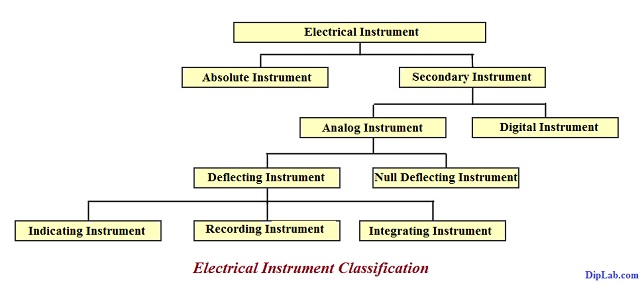
This is the second article based on the electrical instruments- classification of electrical measuring instruments.
Before this article, I shared an electrical measuring Instrument covering all different instruments and their uses.
The main functions of the measuring instrument are indicating, recording, detecting, controlling, and testing the electrical units. These instruments are available in analog or digital form.
Mostly, analog meters are used in the electrical laboratory for practical studies. And digital meters are mostly used for commercial, industrial, and various other purposes.
Let’s study, what are the different types of electrical measuring instruments.
Classification of Electrical Measuring Instruments
On the basis of the electrical and electronic study, measuring instruments are classified into different categories with different perspectives.

I am describing each classified electrical measuring instrument, by one-by-one.
Classification according to the Electrical Quantity
As per the Electrical Quantities, instruments are broadly classified into two parts.
- Absolute Instrument
- Secondary Instrument
Explanation as,
1. Absolute Instrument
This instrument gives the value of the electrical quantity to measure in terms of the constant and its deflection. This instrument is known as ‘Absolute Instrument’.
It is also called a Primary Instrument or Indirect Instrument. These instruments are not required to compare with the standard values.
Example: Tangent Galvanometer is the best example of an absolute instrument. It is used for detecting and displaying an electric current unit.
These types of instruments are rarely used for commercial purposes.
2. Secondary Instrument
The instrument gives the value of the quantity to be measured directly into the deflection. This instrument is known as ‘Secondary Instrument’.
It is also called as Direct Instruments.
These instrument values are required to compare with absolute instruments or the standard values of the instruments.
The secondary instrument is classified into two-part,
- Deflection Instrument
- Null Deflection Instrument
Example: Ammeter, Voltmeter, Wattmeter, etc are examples of secondary instruments.
Classification according to the Nature of the Operation
The instrument can also be classified based on the nature of the operation. They majorly fall into the secondary instrument.
This instrument is divided into four major parts.
- Indicating Instrument
- Recording Instrument
- Integrating Instrument
- Null Deflection instrument
Shortly describe as,
1. Indicating Instrument
The Indicating Instrument displays only the value of the electrical quantities per time of measurement.
This instrument gives the reading only when connected to the electrical supply. Otherwise, it goes to the zero position.
Example: Ammeters, Voltmeters, Wattmeters, etc are examples of the indicating instrument.
2. Recording Instrument
The Recording Instrument displays and records the reading of the electrical quantities at per time of measurement.
This instrument is generally used in the Generating Station and Substation.
Example: ECG, and X-Rays are examples of recording instruments.
3. Integrating Instrument
The Integrating Instrument displays, record, and add the numerical value of the reading of the electrical quantities per time of measurement.
Example: Energy meter, and Ampere-hour meter are examples of the integrating instrument.
4. Null Deflection Instrument
The Null Deflection Instrument shows the reading of the electrical quantities without the deflection angle at per time of measurement.
Example: The potentiometer is an example of a null deflection instrument.
Classification according to the Electrical Supply
This classification is based on the alternating current (AC) and direct current (DC)types of an electrical sources.
- AC Instrument
- DC Instrument
1. AC Instrument
The AC Instrument is connected to the AC supply. Further, they are classified into two parts…
- Single Phase AC Instrument
- Three Phase AC Instrument
Example: Moving Instrument [M.I.], Induction Instrument, Electrostatic Instrument, dynamometer Instrument, and Electrostatic Instrument are examples of the AC Instruments.
2. DC Instrument
The instrument is connected with the DC supply.
Example: ‘Permanent Magnet Moving Coil Instruments’ is the best example of the DC instrument.
Classification according to the Effect
Due to the various magnetic effects, electromagnetic induction effects, electrostatic effects, thermal effects, chemical effects, etc., there are more chances to get the application or system damaged.
So, multiple types of instruments are used to measure and compare unknown quantities with the standard value. These instruments protect the device.
The classification is as follows.
- Moving Coil Instruments
- Moving Iron Instruments
- Induction Instruments
- Electrostatic Instruments
- Electrolytic Instruments
- Hot Wire Instruments
Classification according to Moving Coil [M.C.] Instrument
The Moving Coil Instrument is classified into two parts.
- Permanent Magnet Moving Coil [PMMC] instrument
- Electrodynamic or Dynamometer types instrument
Classification according to Moving Iron [M.I.] Instrument
The Moving Iron Instrument is classified into two parts.
- Attraction type M.I. instrument
- Repulsion type M.I. instrument
Classification according to an Electrical Application
In daily routine, multiple instruments are used for multiple purposes. Instruments work on AC or DC electrical sources as per the appliance’s use.
Here is the list of the most popular and widely used instruments.
- Ammeter
- Voltmeter
- Ohmmeter
- Multimeter
- Wattmeter
- Fluxmeter
- LCR meter
- Oscilloscope
- Vectorscope
- Synchroscope
- Galvanometer
- Energymeter
- Tachometer
- Speedometer
- Frequency meter
- Capacitance meter
- Power factor meter
- Ampere-hour meter
- Live leakage detector
- Earth leakage detector
- Phase sequence detector
- Insulation fault-detecting instrument
- Megger, etc.
These instruments are used for commercial, industrial, practical, and many more purposes. They are manufactured by the topmost electrical companies.
There is also one more type of instrument called a multimeter.
What is a Multimeter?
A multimeter is a popular type of electrical measuring instrument. Like its name, it works like an ammeter, voltmeter, and ohmmeter to measure current, voltage, and resistance respectively.
The multimeter is available in two different forms, like-
- Analog type Multimeter
- Digital type Multimeter
In this advanced technology, both types of meters are needful as per requirement.
What are the advantages of a digital multimeter over an analog multimeter?
The analog type of multimeter shows the continuous signal. It detects and displays the electrical reading by using the moving pointer.
Whereas, the digital type of multimeter shows the discrete signal. And it measures and displays the numeric measuring unit or value.
So, a digital multimeter (DMM) gives a more accurate, fast response, and readable digital output over an analog multimeter.
A digital meter is also called as ‘Smart Meter ‘ or ‘Advance Meter’.
With this single smart meter, you can measure multiple units. Instead of buying separate meters to measure current, voltage, resistance, and so on, you buy digital a multimeter.
Similarly, the LCR meter is a type of multimeter that measures the inductance (L), capacitance (C), and resistance (R).
From this study, we conclude that measurements and instruments are the most essential term in electrical, electronics, mechanical, and other related fields.
These types of instruments in instrumentation work as protective devices and are helpful for building electrical and electronic projects.
That’s all about types of measuring instruments in electrical and mechanical.
Read more related Articles:
- Analog signal vs Digital signal
- Analog multimeter vs Digital multimeter
- Voltmeter vs Potentiometer
- Ammeter vs Voltmeter
- Pros & Cons of digital multimeter
- Digital pulse oximeter
- Different types of Sensors
If you have any queries or points to discuss regarding different types of measuring instruments, write in the comment.
Thanks for Reading!
Thanks for sharing this invalueable knowledge about measuring instruments. It so generous of you.
You’re most welcome,atomck.
Thank you mam very use full topics.
You’re welcome:)
It was a very nice article, very nicely summarize all Electrical measuring instrumentation.
Thanks for sharing this knowledge, and hope I will get more interesting topics further.
Thanks, Nikhil for reaching out to my blog and sharing a few words for a blog.
Sure, I will share more articles.
Thank you so much for providing this information ,that too in systematic order. This helped me a lot.
This is a very interesting and amazing post. There some best points about electrical measuring instruments. It’s really the best post. I am very thankful for this post.
Thank you, Ellison!
Thanks for the knowledge shared.
It’s my pleasure, Chika 🙂
Thanks for sharing the informative tips about the classification electrical measuring instruments nice post! I like your post.
Thanks, Nill for sharing inspiration word for the post.
Thank you, Soo much for The great assistance.
It’s my pleasure, Baguma Emmy 🙂
Very good writeup to easily understand.
Thanks, Jam 🙂
many thanks for your quiz
You’re welcome 🙂
many thanks for your quiz, it is very useful for my interview
Thanks, Manikannam finds it helpful and informative.
All the Best!
This is very helpful simple and easy to understand. Thanks.
Thank you, Ajibade for reaching out.